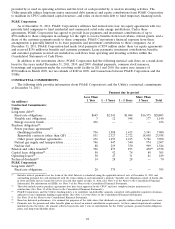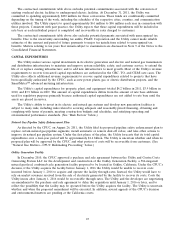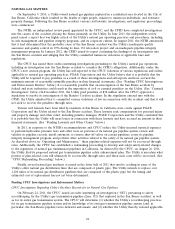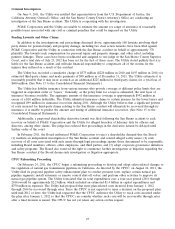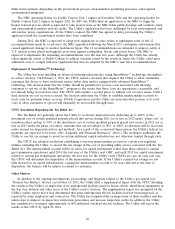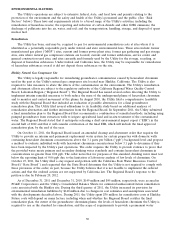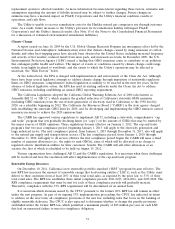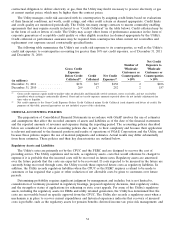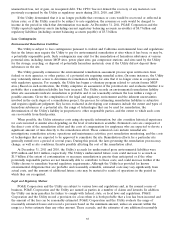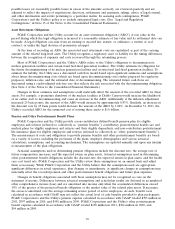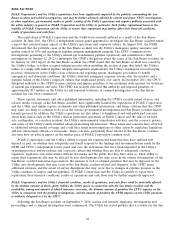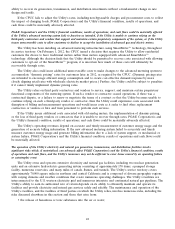PG&E 2011 Annual Report Download - page 36
Download and view the complete annual report
Please find page 36 of the 2011 PG&E annual report below. You can navigate through the pages in the report by either clicking on the pages listed below, or by using the keyword search tool below to find specific information within the annual report.Additionally, the California Energy Commission, which continues to have responsibility for certifying the
eligibility of renewable resources and verifying LSE compliance with the RPS program, has also initiated a
proceeding to implement the new RPS law and is expected to issue one or more draft regulations implementing the
33% legislation in the first half of 2012.
The Utility has made substantial financial commitments as a result of its agreements to purchase renewable
energy to meet RPS requirements. (See Note 15 of the Notes to the Consolidated Financial Statements.) The costs
incurred by the Utility under third-party contracts to meet RPS requirements are recovered with other procurement
costs through rates. The costs of Utility-owned renewable generation projects will be recoverable through traditional
cost-of-service ratemaking mechanisms provided that costs do not exceed the maximums authorized by the CPUC for
the respective project.
Water Quality
Section 316(b) of the federal Clean Water Act requires that cooling water intake structures at electric power
plants, such as the nuclear generation facilities at Diablo Canyon, reflect the best technology available to minimize
adverse environmental impacts. On April 20, 2011, the EPA published draft regulations that propose specific
reductions for impingement (which occurs when larger organisms are caught on water filter screens) and provide a
case-by-case site specific assessment to establish compliance requirements for entrainment (which occurs when
organisms are drawn through the cooling water system). The proposed site specific assessment allows for the
consideration of a variety of factors including social costs and benefits, energy reliability, land availability, and
non-water quality adverse impacts. The draft regulations were subject to public comment and final regulations are
not expected until July 2012.
The State Board also has adopted a policy on once-through cooling. The policy, effective October 1, 2010,
generally requires the installation of cooling towers or other significant measures to reduce the impact on marine life
from existing power generation facilities by at least 85%. However, with respect to the state’s nuclear power
generation facilities, the policy allows other compliance measures to be taken if the costs to install cooling towers are
‘‘wholly out of proportion’’ to the costs considered by the State Board in developing its policy or if the installation of
cooling towers would be ‘‘wholly unreasonable’’ after considering non-cost factors such as engineering and permitting
constraints and adverse environmental impacts. The Utility believes that the costs to install cooling towers at Diablo
Canyon, which could be as much as $4.5 billion, will meet the ‘‘wholly out of proportion’’ test. The Utility also
believes that the installation of cooling towers at Diablo Canyon would be ‘‘wholly unreasonable.’’ If the State Board
disagreed and if the installation of cooling towers at Diablo Canyon were not technically or economically feasible, the
Utility may be forced to cease operations at Diablo Canyon and may incur a material charge. Assuming the State
Board does not require the installation of cooling towers at Diablo Canyon, the Utility could incur significant costs
to comply with alternative compliance measures or to make payments to support various environmental mitigation
projects. The Utility would seek to recover such costs in rates. The Utility’s Diablo Canyon operations must be in
compliance with the State Board’s policy by December 31, 2024.
LEGAL MATTERS
In addition to the provisions made for contingencies related to the San Bruno accident, PG&E Corporation’s
and the Utility’s Consolidated Financial Statements also include provisions for claims and lawsuits that have arisen in
the ordinary course of business, regulatory proceedings, and other legal matters. See ‘‘Legal and Regulatory
Contingencies’’ in Note 15 of the Notes to the Consolidated Financial Statements.
OFF-BALANCE SHEET ARRANGEMENTS
PG&E Corporation and the Utility do not have any off-balance sheet arrangements that have had, or are
reasonably likely to have, a current or future material effect on their financial condition, changes in financial
condition, revenues or expenses, results of operations, liquidity, capital expenditures, or capital resources, other than
those discussed in Note 2 (PG&E Corporation’s tax equity financing agreements) and Note 15 of the Notes to the
Consolidated Financial Statements (the Utility’s commodity purchase agreements).
RISK MANAGEMENT ACTIVITIES
The Utility and PG&E Corporation, mainly through its ownership of the Utility, are exposed to market risk,
which is the risk that changes in market conditions will adversely affect net income or cash flows. PG&E Corporation
and the Utility face market risk associated with their operations; their financing arrangements; the marketplace for
32


